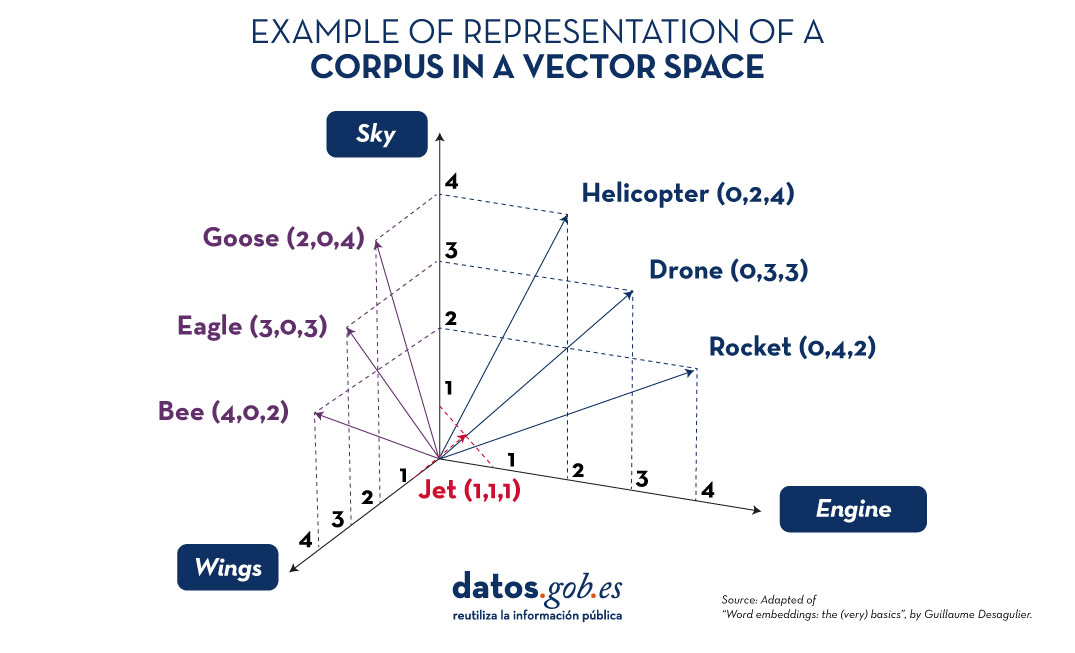
Natural language processing (NLP) is a branch of artificial intelligence that allows machines to understand and manipulate human language. At the core of many modern applications, such as virtual assistants, machine translation and chatbots, are word embeddings. But what exactly are they and why are they so important?
What are word embeddings?
Word embeddings are a technique that allows machines to represent the meaning of words in such a way that complex relationships between words can be captured. To understand this, let's think about how words are used in a given context: a word acquires meaning depending on the words surrounding it. For example, the word bank can refer to a financial institution or to a headquarters, depending on the context in which it is found.
To visualise this, imagine that words like lake, river and ocean would be close together in this space, while words like lake and building would be much further apart. This structure enables language processing algorithms to perform complex tasks, such as finding synonyms, making accurate translations or even answering context-based questions.
How are word embeddings created?
The main objective of word embeddings is to capture semantic relationships and contextual information of words, transforming them into numerical representations that can be understood by machine learning algorithms. Instead of working with raw text, machines require words to be converted into numbers in order to identify patterns and relationships effectively.
The process of creating word embeddings consists of training a model on a large corpus of text, such as Wikipedia articles or news items, to learn the structure of the language. The first step involves performing a series of pre-processing on the corpus, which includes tokenise the words, removing punctuation and irrelevant terms, and, in some cases, converting the entire text to lower case to maintain consistency.
The use of context to capture meaning
Once the text has been pre-processed, a technique known as "sliding context window" is used to extract information. This means that, for each target word, the surrounding words within a certain range are taken into account. For example, if the context window is 3 words, for the word airplane in the sentence "The plane takes off at six o'clock", the context words will be The, takes off, to.
The model is trained to learn to predict a target word using the words in its context (or conversely, to predict the context from the target word). To do this, the algorithm adjusts its parameters so that the vectors assigned to each word are closer in vector space if those words appear frequently in similar contexts.
How models learn language structure
The creation of word embeddings is based on the ability of these models to identify patterns and semantic relationships. During training, the model adjusts the values of the vectors so that words that often share contexts have similar representations. For example, if airplane and helicopter are frequently used in similar phrases (e.g. in the context of air transport), the vectors of airplane and helicopter will be close together in vector space.
As the model processes more and more examples of sentences, it refines the positions of the vectors in the continuous space. Thus, the vectors reflect not only semantic proximity, but also other relationships such as synonyms, categories (e.g., fruits, animals) and hierarchical relationships (e.g., dog and animal).
A simplified example
Imagine a small corpus of only six words: guitar, bass, drums, piano, car and bicycle. Suppose that each word is represented in a three-dimensional vector space as follows:
guitar [0.3, 0.8, -0.1]
bass [0.4, 0.7, -0.2]
drums [0.2, 0.9, -0.1]
piano [0.1, 0.6, -0.3]
car [0.8, -0.1, 0.6]
bicycle [0.7, -0.2, 0.5]
In this simplified example, the words guitar, bass, drums and piano represent musical instruments and are located close to each other in vector space, as they are used in similar contexts. In contrast, car and bicycle, which belong to the category of means of transport, are distant from musical instruments but close to each other. This other image shows how different terms related to sky, wings and engineering would look like in a vector space.

Figure 1. Examples of representation of a corpus in a vector space. Source: Adapted from “Word embeddings: the (very) basics”, by Guillaume Desagulier.
This example only uses three dimensions to illustrate the idea, but in practice, word embeddings usually have between 100 and 300 dimensions to capture more complex semantic relationships and linguistic nuances.
The result is a set of vectors that efficiently represent each word, allowing language processing models to identify patterns and semantic relationships more accurately. With these vectors, machines can perform advanced tasks such as semantic search, text classification and question answering, significantly improving natural language understanding.
Strategies for generating word embeddings
Over the years, multiple approaches and techniques have been developed to generate word embeddings. Each strategy has its own way of capturing the meaning and semantic relationships of words, resulting in different characteristics and uses. Some of the main strategies are presented below:
1. Word2Vec: local context capture
Developed by Google, Word2Vec is one of the most popular approaches and is based on the idea that the meaning of a word is defined by its context. It uses two main approaches:
- CBOW (Continuous Bag of Words): In this approach, the model predicts the target word using the words in its immediate environment. For example, given a context such as "The dog is ___ in the garden", the model attempts to predict the word playing, based on the words The, dog, is and garden.
- Skip-gram: Conversely, Skip-gram uses a target word to predict the surrounding words. Using the same example, if the target word is playing, the model would try to predict that the words in its environment are The, dog, is and garden.
The key idea is that Word2Vec trains the model to capture semantic proximity across many iterations on a large corpus of text. Words that tend to appear together have closer vectors, while unrelated words appear further apart.
2. GloVe: global statistics-based approach
GloVe, developed at Stanford University, differs from Word2Vec by using global co-occurrence statistics of words in a corpus. Instead of considering only the immediate context, GloVe is based on the frequency with which two words appear together in the whole corpus.
For example, if bread and butter appear together frequently, but bread and planet are rarely found in the same context, the model adjusts the vectors so that bread and butter are close together in vector space.
This allows GloVe to capture broader global relationships between words and to make the representations more robust at the semantic level. Models trained with GloVe tend to perform well on analogy and word similarity tasks.
3. FastText: subword capture
FastText, developed by Facebook, improves on Word2Vec by introducing the idea of breaking down words into sub-words. Instead of treating each word as an indivisible unit, FastText represents each word as a sum of n-grams. For example, the word playing could be broken down into play, ayi, ing, and so on.
This allows FastText to capture similarities even between words that did not appear explicitly in the training corpus, such as morphological variations (playing, play, player). This is particularly useful for languages with many grammatical variations.
4. Embeddings contextuales: dynamic sense-making
Models such as BERT and ELMo represent a significant advance in word embeddings. Unlike the previous strategies, which generate a single vector for each word regardless of the context, contextual embeddings generate different vectors for the same word depending on its use in the sentence.
For example, the word bank will have a different vector in the sentence "I sat on the park bench" than in "the bank approved my credit application". This variability is achieved by training the model on large text corpora in a bidirectional manner, i.e. considering not only the words preceding the target word, but also those following it.
Practical applications of word embeddings
ord embeddings are used in a variety of natural language processing applications, including:
- Named Entity Recognition (NER): allows you to identify and classify names of people, organisations and places in a text. For example, in the sentence "Apple announced its new headquarters in Cupertino", the word embeddings allow the model to understand that Apple is an organisation and Cupertino is a place.
- Automatic translation: helps to represent words in a language-independent way. By training a model with texts in different languages, representations can be generated that capture the underlying meaning of words, facilitating the translation of complete sentences with a higher level of semantic accuracy.
- Information retrieval systems: in search engines and recommender systems, word embeddings improve the match between user queries and relevant documents. By capturing semantic similarities, they allow even non-exact queries to be matched with useful results. For example, if a user searches for "medicine for headache", the system can suggest results related to analgesics thanks to the similarities captured in the vectors.
- Q&A systems: word embeddings are essential in systems such as chatbots and virtual assistants, where they help to understand the intent behind questions and find relevant answers. For example, for the question "What is the capital of Italy?", the word embeddings allow the system to understand the relationship between capital and Italy and find Rome as an answer.
- Sentiment analysis: word embeddings are used in models that determine whether the sentiment expressed in a text is positive, negative or neutral. By analysing the relationships between words in different contexts, the model can identify patterns of use that indicate certain feelings, such as joy, sadness or anger.
- Semantic clustering and similarity detection: word embeddings also allow you to measure the semantic similarity between documents, phrases or words. This is used for tasks such as grouping related items, recommending products based on text descriptions or even detecting duplicates and similar content in large databases.
Conclusion
Word embeddings have transformed the field of natural language processing by providing dense and meaningful representations of words, capable of capturing their semantic and contextual relationships. With the emergence of contextual embeddings , the potential of these representations continues to grow, allowing machines to understand even the subtleties and ambiguities of human language. From applications in translation and search systems, to chatbots and sentiment analysis, word embeddings will continue to be a fundamental tool for the development of increasingly advanced and humanised natural language technologies.
Content prepared by Juan Benavente, senior industrial engineer and expert in technologies linked to the data economy. The contents and points of view reflected in this publication are the sole responsibility of the author.


